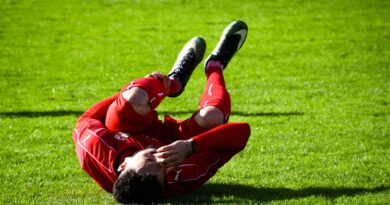Delayed Onset Muscle Soreness [DOMS]-how To Overcome This
Delayed Onset Muscle Soreness (DOMS)
Recently in my OPD , Young well build fellow came with complaints of severe muscle soreness and body ache. He told that he has such a severe pain in legs and calf that he was barely able to get up walk, and it was real deal to walk on stairs since last 2 days.
On more discussion, when I asked about his workout schedule , he explained that visited gym after gap of 3 months and started his strength training as usual and started with “leg day”.
He did not realize that workout after such long gap is to be done gradually, increasing the weight in next few days. He was very afraid that he just pulled his muscles and may have done some permanent damage and his family was also so much worried seeing him like this. Actually what has happened is called Delayed Onset Muscle Soreness (DOMS)
WHAT IS DOMS?
Delayed Onset Muscle Soreness (DOMS) is a condition that is commonly experienced by people after engaging in strenuous exercise or physical activity. It is characterized by muscle pain, stiffness, and tenderness that typically occur 24-72 hours after the activity. While DOMS is a normal response to physical activity and a sign that the muscles are adapting and becoming stronger, it can be uncomfortable and may affect daily activities, especially in the first few days after the onset of symptoms. In this series of questions and answers, we will explore the causes, symptoms, and treatments of DOMS, as well as preventive measures that can help reduce the risk of experiencing this condition.
What are 3 symptoms of DOMS?
The three common symptoms of Delayed Onset Muscle Soreness (DOMS) are
- muscle pain,
- stiffness,
- tenderness.
These symptoms typically appear 24-72 hours after engaging in intense or unaccustomed exercise, and they can vary in intensity depending on the severity of the condition and the muscles involved.
Some people may also experience swelling, reduced range of motion, and weakness in the affected muscles. In general, the symptoms of DOMS are temporary and should improve within a few days to a week with proper rest, hydration, and self-care.
What is the main cause of DOMS?

The main cause of Delayed Onset Muscle Soreness (DOMS) is microscopic tears in the muscle fibers and connective tissues that occur during exercise or physical activity.
These tears result in inflammation and irritation of the affected muscles, which can cause pain, stiffness, and tenderness. DOMS typically occurs after engaging in intense or unaccustomed exercise, such as lifting weights or running downhill, and is more likely to occur when muscles are stretched or contracted while under tension.
While the exact mechanisms of DOMS are not fully understood, research suggests that it may be related to inflammation, oxidative stress, and other factors that contribute to muscle damage and repair.
While DOMS can be uncomfortable, it is a normal and expected response to physical activity, and it typically resolves within a few days to a week with proper rest, hydration, and self-care.
What does having DOMS mean?
DOMS stands for Delayed Onset Muscle Soreness. It is a type of muscle pain and stiffness that typically develops after a strenuous or unaccustomed exercise. DOMS usually occurs 24-48 hours after the exercise and is characterized by soreness, stiffness, and tenderness in the affected muscles. It is believed to be caused by microscopic damage to the muscle fibers and connective tissues, which triggers an inflammatory response in the body. While DOMS can be uncomfortable, it is a normal part of the muscle repair process, and the symptoms typically subside within a few days.
Are DOMS a good thing?
DOMS, or Delayed Onset Muscle Soreness, can be a sign of muscle growth and adaptation, which can be a good thing for people who are looking to increase their strength or fitness level. When muscles are put under stress during exercise, they can develop small tears or damage to the muscle fibers, which can cause the soreness associated with DOMS. However, this damage triggers a repair and growth process, where the body rebuilds the muscle fibers to become stronger and better able to handle the stress in the future.
While DOMS can be a positive sign of muscle growth and adaptation, it is important to note that it is not necessary for muscle growth to occur. It is possible to make progress in strength and fitness without experiencing DOMS, and overdoing it can lead to injury and hinder progress. It is important to listen to your body, gradually increase the intensity and frequency of your workouts, and allow for proper rest and recovery time between workouts.
What is the fastest way to cure DOMS?
While there is no guaranteed way to cure DOMS, there are several strategies that may help alleviate the symptoms and speed up the recovery process. Here are some tips:
- Gentle exercise: Engaging in light exercise or gentle stretching may help increase blood flow to the affected muscles, which can help reduce soreness and stiffness. However, it is important to avoid overexerting the muscles, as this can lead to further damage and prolong the recovery process.
- Massage: Massaging the affected muscles can help increase blood flow and reduce soreness. Foam rolling, using a massage ball, or getting a professional massage may all be helpful.
- Heat therapy: Applying heat to the affected muscles, such as taking a warm bath or using a heating pad, may help increase blood flow and reduce soreness.
- Rest and recovery: Giving your muscles time to rest and recover is important for the healing process. It is recommended to avoid strenuous exercise that targets the affected muscles until the soreness subsides.
- Proper nutrition: Eating a well-balanced diet that includes plenty of protein, carbohydrates, and healthy fats can help support muscle repair and recovery.
Remember, the best way to prevent DOMS is to gradually increase the intensity and duration of your workouts, allow for proper rest and recovery time, and listen to your body to avoid overexertion.
How can DOMS be avoided?
DOMS, or Delayed Onset Muscle Soreness, can be difficult to completely avoid, especially if you are new to exercise or if you are changing up your workout routine. However, there are several strategies that may help reduce the likelihood or severity of DOMS:
- Gradual progression: Gradually increasing the intensity, frequency, and duration of your workouts can help your muscles adapt to the stress and reduce the likelihood of developing DOMS.
- Warm-up and cool-down: Taking the time to properly warm up your muscles before exercising and cool down afterwards may help reduce the risk of developing DOMS.
- Proper form: Using proper form and technique during exercise can help reduce the risk of injury and excessive muscle damage, which can lead to DOMS.
- Rest and recovery: Giving your muscles time to rest and recover between workouts is important for muscle repair and growth. It is recommended to take at least one day off per week and avoid over-exerting the same muscles multiple days in a row.
- Hydration and nutrition: Staying properly hydrated and fueling your body with a well-balanced diet that includes plenty of protein, carbohydrates, and healthy fats can help support muscle repair and recovery.
It’s important to note that while these strategies may help reduce the likelihood or severity of DOMS, it is not always possible to completely avoid it, especially when trying new exercises or increasing the intensity of your workouts. If you do experience DOMS, it’s important to allow your muscles time to rest and recover, and to avoid over-exerting the affected muscles until the soreness subsides.
Is DOMS good for muscle growth?
DOMS, or Delayed Onset Muscle Soreness, can be a sign that your muscles have been challenged and are adapting to the stress, which can lead to muscle growth and strength gains over time. When muscles are put under stress during exercise, they can develop small tears or damage to the muscle fibers, which can cause the soreness associated with DOMS. However, this damage triggers a repair and growth process, where the body rebuilds the muscle fibers to become stronger and better able to handle the stress in the future.
That being said, it is not necessary to experience DOMS in order to see muscle growth or strength gains. It is possible to make progress in strength and fitness without experiencing DOMS, and overdoing it can lead to injury and hinder progress. It is important to listen to your body, gradually increase the intensity and frequency of your workouts, and allow for proper rest and recovery time between workouts. Consistency, proper nutrition, and proper exercise progression are key factors in muscle growth and strength gains.
Why are DOMS so painful?
DOMS, or Delayed Onset Muscle Soreness, can be quite painful due to the inflammatory response and muscle damage that occurs after strenuous exercise or unaccustomed activity. When muscles are put under stress, such as during intense exercise, they can develop small tears or damage to the muscle fibers. This damage can lead to an inflammatory response, where the body sends white blood cells to the affected area to help repair the damage. This inflammatory response can cause swelling and pain, which can be felt as soreness or stiffness in the affected muscles.
Additionally, DOMS can be caused by the buildup of metabolic waste products, such as lactic acid, in the muscles during intense exercise. These waste products can cause muscle fatigue and contribute to the soreness felt after exercise.
The degree of pain and soreness associated with DOMS can vary depending on a number of factors, including the intensity and duration of the exercise, the individual’s fitness level, and the specific muscles being worked. While DOMS can be uncomfortable, it is typically a normal response to exercise and should subside within a few days. It is important to allow the muscles time to rest and recover, and to avoid over-exerting the affected muscles until the soreness subsides.
How long do DOMS last?
DOMS can last anywhere from a few days to a week or more, depending on the severity of the soreness and the individual’s recovery time. Typically, DOMS will start to appear within 24-48 hours after exercise and will gradually increase in intensity for the first 48-72 hours before starting to subside.
After this initial period, the soreness may continue to linger for several more days, especially if the muscles are not allowed sufficient time to rest and recover.
The duration and severity of DOMS can vary depending on several factors, including the intensity and duration of the exercise, the individual’s fitness level, the specific muscles being worked, and how well the individual is taking care of their body after the exercise. Engaging in light exercise or gentle stretching, massaging the affected muscles, applying heat or cold therapy, and getting enough rest and hydration can all help alleviate the symptoms of DOMS and speed up the recovery process.
Do DOMS burn fat or Calories?
DOMS is not directly related to burning fat. DOMS is a normal response to exercise and is caused by the stress and damage placed on the muscles during intense or unaccustomed activity. While exercise can contribute to overall fat loss by increasing the number of calories burned and helping to build lean muscle mass, DOMS itself is not directly responsible for burning fat.
However, engaging in regular exercise, even if it does not cause DOMS, can contribute to calorie burning by increasing metabolism, building lean muscle mass, and burning calories.
The intensity and duration of the exercise can play a role in the number of calories burned, with more intense or longer-duration exercise typically burning more calories. Additionally, proper nutrition and hydration can also play a role in supporting calorie burning goals.
Should I skip a workout if I’m sore?
Whether or not to skip a workout if you’re sore depends on the severity of the soreness and the type of workout you have planned. If you have mild soreness and discomfort, it is generally safe to continue with your planned workout, although you may want to adjust the intensity or duration to avoid further stressing the affected muscles.
However, if you have severe or debilitating soreness, it may be best to take a rest day or engage in light exercise to allow your body time to recover. Overworking sore muscles can potentially lead to further damage or injury, so it’s important to listen to your body and adjust your exercise routine as needed.
Additionally, if you are experiencing pain or soreness that is beyond what you would normally expect from exercise, or if the soreness is accompanied by other symptoms such as swelling or bruising, it’s important to consult a medical professional before continuing with exercise. They can help determine if there is an underlying injury or condition that needs to be addressed before returning to exercise.
Conclusion :-
If you do have DOMS, there are few home remedies you can do to relieve pain & speed up recovery-
- Ice packs or cold compresses application ;
- Switch to warm packs for 15 minutes .
- Can take an OTC anti-inflammatory drugs or contact your doctor.
Do not take any medication without consulting any doctor for longer period of time as it can cause some serious health issues!



